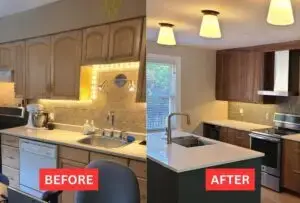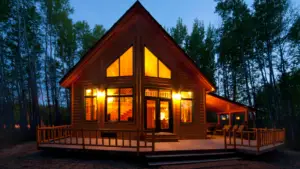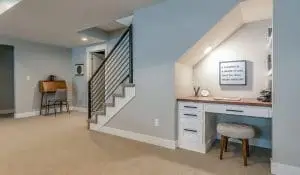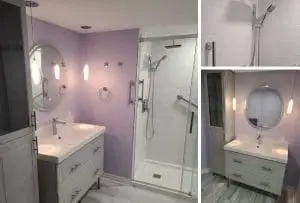Have a Clear Pathway
Before installing any additions to assist in entering and exiting, you should first take a look at the walkway leading up to your entryway. This should be cleared from any obstacles, such as overgrown hedges and garden debris. If there is any patio stones that are weathered and buckling or loose, these should be addressed and replaced first.Before stepping up your home’s accessibility, ensure a smooth and safe pathway to your entryway. Here’s how:
1. Clear the Path:
- Remove obstacles: Eliminate overgrown hedges, branches, garden debris, or anything that could obstruct the walkway.
- Address uneven surfaces: Repair or replace cracked, buckling, or loose patio stones that pose tripping hazards.
- Trim back vegetation: Ensure plants and shrubs don’t encroach on the pathway, especially near steps or railings.
2. Enhance Visibility:
- Install proper lighting: Brighten the walkway with motion-sensor lights or solar-powered options for improved visibility, especially at night and during bad weather.
- Clear snow and ice promptly: Keep the pathway free of wintery hazards to prevent slips and falls.
3. Consider Additional Safety Measures:
- Handrails: Install sturdy handrails on both sides of steps or along inclined walkways for added support and balance.
- Non-slip surfaces: Opt for textured or non-slip surfaces on walkways and steps to minimize the risk of slipping, especially in wet or icy conditions.
- Contrasting colors: Use contrasting colors for steps and edges to improve visibility, particularly for those with visual impairments.

Light It Up
Having proper lighting is also crucial to avoid injury and make it easy to get to and from your home. Light features should be installed to illuminate any walkway or paths that provide access to your home. You can install a motion light that will kick on once someone approaches the entryway to ensure the door handle and lock is clearly visible at all times.Having a clear pathway is crucial for safe and easy access to your home, but don’t underestimate the power of proper lighting. Here’s how to “light it up” for both practical and aesthetic purposes:
Safety First:
- Brighten the entrance: Use motion-sensor or automatic lights to illuminate the walkway and entryway, especially at night. Consider solar-powered options for an eco-friendly solution.
- Step it up: Illuminate steps with well-placed lights to prevent tripping hazards. This is especially important for uneven or winding pathways.
- Clear sightlines: Avoid light spillage onto neighboring properties or creating glare towards oncoming pedestrians.
Beyond Safety:
- Create ambiance: Use warm-toned lights to create a welcoming and inviting atmosphere at your entryway. String lights, lanterns, or recessed lighting can add charm and character.
- Highlight features: Showcase landscaping elements, sculptures, or architectural details with focused spotlights or uplighting.
- Set the mood: Consider using smart lighting that allows you to adjust brightness and color temperature to create different moods and ambiences for various occasions.
Additional Tips:
- Follow local regulations: Make sure your lighting installation complies with local ordinances regarding light pollution and nighttime illumination.
- Think long-term: Choose durable and weatherproof fixtures that can withstand the elements.
- Professional touch: For complex installations or extensive lighting systems, consider consulting a professional electrician or landscape lighting designer.
By prioritizing safety and incorporating creative elements, you can transform your pathway into a well-lit, welcoming, and aesthetically pleasing extension of your home.
Low Riser, Long-Tread Steps
If you or a family member relies on a walker or crutch, then drastic improvements like installing a ramp might not be necessary. Instead, having low rising steps with long treads can help. These steps provide enough room to accommodate the size of a walker or similar equipment and don’t require taking such a big step up or down. This is a good option when a ramp is impractical but your current steps are too steep and cumbersome.Traditional steps can be daunting for individuals with mobility challenges, but fear not! There’s a game-changer in the game: Low-riser, long-tread steps. Here’s the lowdown on these accessibility heroes:
What are they?
Imagine your usual stairs, but with wider treads and shorter risers, creating a gentle incline rather than a steep climb. This design offers:
- Reduced effort: Smaller riser heights require less leg lift, making navigation easier for those with limited mobility.
- Increased stability: Wider treads provide more platform, improving balance and confidence during each step.
- Reduced fall risk: This combination minimizes the risk of tripping or losing balance compared to standard stairs.
Who benefits?
These steps are ideal for:
- Individuals with mobility limitations due to age, disability, or injury.
- People who use walkers, canes, or wheelchairs (with assistance).
- Families with young children or elderly members for improved accessibility.
Design considerations:
- Riser height: Typically between 4-6 inches, ensuring comfortable step-over for most users.
- Tread depth: Generally double the riser height for adequate foot placement.
- Handrails: Essential on both sides for added support and balance.
- Landing platforms: Consider incorporating level landings at intervals for a safe resting point.
Bonus features:
- Non-slip surfaces: Opt for textured or traction-enhancing materials to prevent slips and falls.
- Contrasting colors: Use contrasting colors for steps and edges to improve visibility, especially for those with visual impairments.
- Lighting: Ensure proper illumination of the steps for safe use during low-light conditions.
Ramps and Vertical Porch Lifts
If you do require accessibility for a wheelchair, scooter or a similar device then a ramp or vertical porch lift can be necessary. Ramps can be customized to your home and entryway, plus, you can have a “suitcase” ramp installed, which can fold up and be carried by handles. Porch lifts can bypass the hassle altogether by carrying a person on their device to the doorway level.When accessibility becomes a concern, both ramps and vertical porch lifts offer solutions to navigate entryways with ease. But choosing the right one depends on various factors. Let’s delve into their strengths and considerations:
Ramps:
- Pros: Affordable, relatively easy to install, offers gradual incline for independent usage by many users.
- Cons: Requires significant space, may not be feasible for steep inclines, can be weather-sensitive, and aesthetics might not blend seamlessly.
Vertical Porch Lifts:
- Pros: Compact and space-saving, overcomes steep inclines efficiently, provides effortless ascent for users with limited mobility.
- Cons: Higher initial cost, requires professional installation, might have potential maintenance needs, and aesthetic integration might require customization.
Making the Choice:
Consider:
- Available space: Ramps need a gradual incline, while lifts require minimal footprint.
- Budget: Ramps are generally cheaper upfront, while lifts have higher initial costs.
- User needs: Evaluate individual mobility level and independence with using each option.
- Aesthetics: Consider how each solution visually integrates with your home’s style.
- Maintenance: Factor in potential upkeep needs for each option.
Additional Options:
- Combined solutions: Consider a combination of a shorter ramp and a lift for specific needs.
- Platform lifts: Explore enclosed platform lifts for additional weather protection.
















